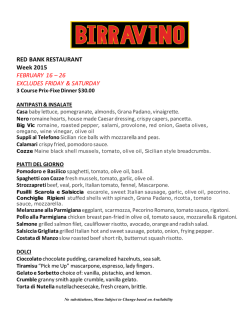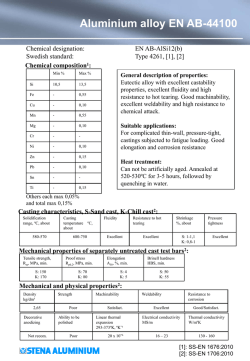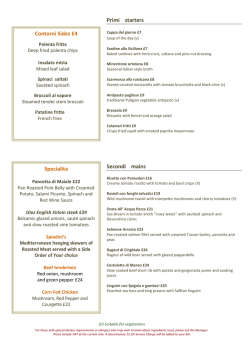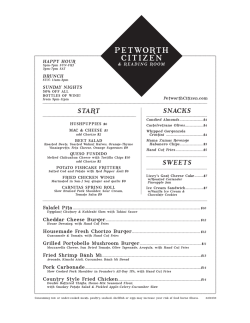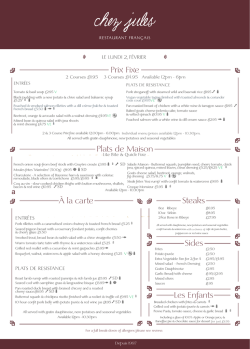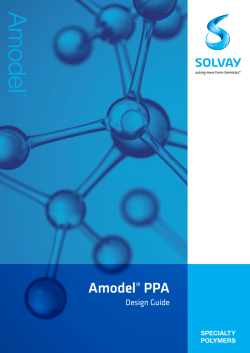
Effect of high pressure homogenization (HPH) on the rheological
Journal of Food Engineering 111 (2012) 570–579 Contents lists available at SciVerse ScienceDirect Journal of Food Engineering journal homepage: www.elsevier.com/locate/jfoodeng Effect of high pressure homogenization (HPH) on the rheological properties of tomato juice: Time-dependent and steady-state shear Pedro E.D. Augusto a,b,⇑, Albert Ibarz c, Marcelo Cristianini a a Department of Food Technology (DTA), School of Food Engineering (FEA), University of Campinas (UNICAMP), Brazil Technical School of Campinas (COTUCA), University of Campinas (UNICAMP), Brazil c Department of Food Technology (DTA), School of Agricultural and Forestry Engineering (ETSEA), University of Lleida (UdL), Lleida, Spain b a r t i c l e Article history: Received 5 October Received in revised Accepted 16 March Available online 23 i n f o 2011 form 25 January 2012 2012 March 2012 Keywords: Food properties High pressure homogenization Rheology Viscosity a b s t r a c t High pressure homogenization (HPH) is a non-thermal technology that has been widely studied as a partial or total substitute for the thermal processing of food. Although microbial inactivation has been widely studied, there are only a few works in the literature reporting the physicochemical changes caused in fruit products due to HPH, especially those regarding the rheological properties. The present work evaluated the effect of HPH (up to 150 MPa) on the time-dependent and steady-state shear rheological properties of tomato juice. HPH reduced the mean particle diameter and particle size distribution (PSD), and increased its consistency and thixotropy. The rheological results were in accordance with the PSD observed. The rheological properties of the juice were evaluated by the Herschel–Bulkley and Falguera–Ibarz models (steady-state shear) and Figoni–Shoemaker and Weltman models (time-dependent). The parameters of these equations were modelled as a function of the homogenization pressure. The models obtained described the experimental values well, and contributed to future studies on product and process development. Ó 2012 Elsevier Ltd. Open access under the Elsevier OA license. 1. Introduction High pressure homogenization (HPH) technology consists of pressurizing a fluid to flow quickly through a narrow gap valve, which greatly increases its velocity, resulting in depressurization with consequent cavitation and high shear stress. Thus particles, cells and macromolecules suspended in the fluid are subjected to high mechanical stress, becoming twisted and deformed (Pinho et al., 2011; Floury et al., 2004). Several studies have evaluated the use of HPH for microbial inactivation in fruit products. The use of HPH as a partial or total substitute for the thermal processing of foods has been studied for tomato (Corbo et al., 2010), apple (Donsì et al., 2009; Pathanibul et al., 2009; Saldo et al., 2009), mango (Tribst et al., 2009, 2011), açaí (Aliberti, 2009), orange (Campos and Cristianini, 2007; Tahiri et al., 2006), carrot (Pathanibul et al., 2009; Patrignani et al., 2009, 2010), banana (Calligaris et al., 2012) and apricot (Patrignani et al., 2009, 2010) juices. However, although microbial inactivation has been widely studied, there are only a few works in the literature regarding the physicochemical changes in fruit products due to high pressure homogenization (HPH) processing, especially regarding their rheological properties. The rheological characterization of food is important for the design of unit operations, process optimization and high quality product assurance (Ibarz and Barbosa-Cánovas, 2003; Rao, 1999). The study of the influence of processing on the rheological properties of foods is thus essential for an efficient product and process design. Tomato is one of the most popular and widely grown vegetables in the world (Nisha et al., inpress). It is also one of the most important vegetables in the food industry, and widely included in the human diet. Homogenization is a commonly used unit operation in tomato processing, and it is well accepted that homogenization increases the apparent viscosity of tomato products (Bayod and Tornberg, 2011; Lopez-Sanchez et al., 2011a; Bayod et al., 2007; Ouden and Vliet, 2002, 1997; Beresovsky et al., 1995; Thakur et al., 1995; Mohr, 1987; Foda and Mccollum, 1970; Whittenberg and Nutting, 1958). However, no papers were found in the literature studying the effect of homogenization on the rheological parameters of tomato products (i.e., the steady-state shear and time-dependent rheological parameters), especially at high pressures (HPH). The present work evaluated the effect of high pressure homogenization (HPH) on the time-dependent and steady-state shear rheological properties of tomato juice. 2. Material and methods ⇑ Corresponding author at: COTUCA/UNICAMP – R. Culto à Ciência, 177, Botafogo, CEP: 13020-060, Campinas, SP, Brazil. Tel.: +55 1935219950. E-mail address: [email protected] (P.E.D. Augusto). 0260-8774 Ó 2012 Elsevier Ltd. Open access under the Elsevier OA license. http://dx.doi.org/10.1016/j.jfoodeng.2012.03.015 A 4.5° Brix tomato juice was obtained by diluting a commercial 30° Brix pulp in distilled water. The commercial pulp was used to P.E.D. Augusto et al. / Journal of Food Engineering 111 (2012) 570–579 571 Nomenclature a b c_ / /m g ga gr g0 g1 [g] q r r0 r0 re slope index of the linear model for the evaluation of the experimental values versus those obtained by models (Eq. (8)) (–) intercept index of the linear model for the evaluation of the experimental values versus those obtained by models (Eq. (8)) (–) shear rate (s1) particle volume fraction (–) maximum packing fraction of solids (–) viscosity [Pas] apparent viscosity (= r/c) (Pas) relative viscosity (Eq. (9)) (Pas) initial viscosity in the Falguera–Ibarz model (Eq. (7)) (Pas) equilibrium viscosity in the Falguera–Ibarz model (Eq. (7)) (Pas) intrinsic viscosity (Pas) particle density (kg m3) shear stress (Pa) yield stress, Herschel–Bulkley model (Eq. (6)) (Pa) initial stress in the Figoni–Shoemaker model (Eq. (4)) (Pa) equilibrium stress in the Figoni–Shoemaker model (Eq. (4)) (Pa) guarantee standardization and repeatability. It was obtained using the hot break process, concentrated by evaporation at 65 °C, thermally processed by the UHT method and aseptically packaged in bags. The pulp was fractionated into small portions in the laboratory, packaged in high density polyethylene bottles and frozen at 18 °C until used. This procedure allowed for the use of the same product for the entire experiment. The samples were thawed at 4 °C, diluted using distilled water at 50 °C to ensure better hydration (Tehrani and Ghandi, 2007), and then allowed to rest for 24 h at 5 °C to ensure complete hydration and release the incorporated air. The juice pH was 4.6. A ASF B d D[4, 3] D[3, 2] k kB kFS kFI n Pe PH r particle V t T structural parameter in the Weltman model (Eq. (5)) (Pa) particle specific surface area (Eq. (3)) (m3g-1) kinetic parameter in the Weltman model (Eq. (5)) (Pas1) particle diameter (m) particle volume-based diameter (Eq. (1)) (m) particle area-based diameter (Eq. (2)) (m) consistency coefficient, Herschel–Bulkley model (Eq. (6)) (Pasn) Boltzman constant (= 1.38 1023 N m K1) kinetic parameter in the Figoni–Shoemaker model (Eq. (4)) (s1) viscosity decline parameter in the Falguera–Ibarz model (Eq. (7)) (–) flow behavior index, Herschel–Bulkley model (Eq. (5)) (–) Peclet number (Eq. (12)) (–) homogenization pressure (MPa) mean suspended particle radius (m) particle volume (m3) time (s) absolute temperature (K) (Lopez-sanchez et al., 2011a; Bengtsson and Tornberg, 2011). The particle specific surface area (ASF) was also obtained, using Eq. (3). P 4 ni d D½4; 3 ¼ Pi i3 i ni di ð1Þ P 3 ni d D½3; 2 ¼ Pi i2 i ni di ð2Þ P 6 i Vdii 6 ASF ¼ P ¼ q i V i q D½3; 2 ð3Þ 2.1. High pressure homogenization (HPH) process The juice was homogenized at 0 MPa (control), 50, 100 and 150 MPa using a high pressure homogenizer (Panda Plus, GEA Niro Soavi, Italy). Samples were introduced at room temperature into the equipment by suction and quickly cooled using an ice bath just after the homogenization valve. The maximum temperature reached was 40 °C (for the sample processed at 150 MPa just before the ice bath). The experiments were carried out with three replicates. 2.2. Particle size distribution (PSD) Sample particle size distribution (PSD) was measured by light scattering (Malvern Mastersizer 2000 with Hydro 2000s, Malvern Instruments Ltd., UK), with three replicates, for the juices processed at 0, 50 and 150 MPa. In addition to the PSD, the volumebased mean diameter was evaluated (D[4,3], Eq. (1); where ni is the number of particles with diameter di) and the area-based mean diameter (D[3,2], Eq. (2)). Both equivalent diameters were evaluated, since the D[4,3] is greatly influenced by large particles, whereas the D[3,2] is more influenced by the smaller ones 2.3. Rheological properties Rheological analyses were carried out using a controlled stress (r) rheometer (AR2000ex, TA Instruments, USA) with a cross hatched plate–plate geometry (40 mm of diameter). The gap dimension (1.0 mm) was determined using a gap-independency procedure as described by Tonon et al. (2009). In this procedure, the distance between the plates was varied and the sample flow behaviour evaluated. The ideal gap dimension was observed when the sample flow behaviour was independent of variations in the gap. The temperature was maintained constant at 25 °C using a Peltier system. The rheological evaluation was carried out with new samples, which were first placed in the rheometer and maintained at rest for 10 min before shearing. After resting, the samples were sheared at a constant shear rate (300 s1) for 10 min, while the shear stress was measured. After the time-dependent shear period, a linear decreasing stepwise protocol (300–0.1 s1) was used to guarantee steady-state shear conditions (7 min). The time-dependent rheological properties of the product were evaluated using the first part of the protocol. The shear stress decay 572 P.E.D. Augusto et al. / Journal of Food Engineering 111 (2012) 570–579 12 was evaluated by two models widely used to describe thixotropy in foods (Ibarz and Barbosa-Cánovas, 2003) and previously evaluated for tomato juice (Augusto et al., inpress). The models evaluated were the Figoni and Shoemaker (1983), (Eq. (4)) and Weltman (1943), (Eq. (5)) models. ð4Þ r ¼ A B ln t ð5Þ The steady-state shear rheological properties of the product were evaluated using the second part of the protocol. The product flow behaviour was modelled using the Herschel–Bulkley model (Eq. (6)), which comprises the Newton, Bingham and Ostwaldde-Waele (power law) models, and has been widely used to describe the rheological properties of food products. Moreover, the flow behaviour of the tomato juice was also evaluated using another rheological model recently proposed by Falguera and Ibarz (2010). In the Falguera–Ibarz model (Eq. (7)), the decline in apparent viscosity ðga ¼ rc_ Þ with the shear rate is described by a power equation, from an initial value (g0) to an equilibrium one (g1). r ¼ r0 þ k c_ n ð6Þ _ ðkFI Þ ga ¼ g1 þ ðg0 g1 Þ c ð7Þ Each parameter in Eqs. (4)–(7) was then modelled as a function of the homogenization pressure (PH) and the rheological parameter (‘‘RP’’, i.e., r for the Figoni–Shoemaker, Weltman and Herschel– Bulkley models, and ga for the Falguera–Ibarz model) obtained by the models (RPmodel) plotted as a function of the experimental values (RPexperimental). The regression of these data to a linear function (Eq. (8)) results in three parameters that can be used to evaluate the description of the experimental values by the models, i.e. the linear slope (a; that must be as close as possible to the unity), the intercept (b; that must be as close as possible to zero) and the coefficient of determination (R2; that must be as close as possible to the unity). RP model ¼ a RP experimental þ b ð8Þ The parameters for each model were obtained by linear or nonlinear regression using the software CurveExpert Professional (v.1.2.0, http://www.curveexpert.net/, USA) with a significant probability level of 95%. 3. Results and discussion 3.1. Particle size distribution (PSD) Fig. 1 shows the effect of HPH (0–150 MPa) on the tomato juice particle size distribution (PSD). As expected, the homogenization processing reduced the mean particle diameter, as previously observed for various tomato products (up to 9 MPa, Bayod and Tornberg, 2011; Bengtsson and Tornberg, 2011; Bayod et al., 2008; up to 60 MPa, Lopez-Sanchez et al., 2011a) and other vegetable products, such as passion fruit juice (up to 28 MPa, Okoth et al., 2000), citrus juices (up to 30 MPa, Betoret et al., 2009; Sentandreu et al., 2011; up to 170 MPa, Lacroix et al., 2005), apple juice (up to 200 MPa, Donsì et al., 2009), apple, broccoli, carrot and potato sauces (up to 9 MPa, Bengtsson and Tornberg, 2011; up to 60 MPa, Lopez-Sanchez et al., 2011a). Moreover, as can be seen in Fig. 1, not only was the mean diameter affected by the HPH but also the particle size distribution (PSD). The control juice showed a monomodal distribution, with particle diameters ranging between 100 and 1000 lm. When the juice was processed at 50 MPa, a broader distribution was observed, with particles ranging between 10 and 1000 lm. 50 MPa volume (%) r ¼ re þ ðr0 re Þ expðkFS tÞ 0 MPa 150 MPa 8 4 0 1 10 100 particle size (μ μ m) 1000 Fig. 1. Effect of HPH (0–150 MPa) on the tomato juice particle size distribution (PSD). Mean of three replicates. Finally, when the juice processed at 150 MPa was evaluated, a further reduction in particle diameter and narrower distribution (10 to 300 lm) were seen. Moreover, the changes in particle diameter between 50 and 150 MPa were less pronounced then those between 0 MPa and 50 MPa. Similar behaviour was observed by Silva et al. (2010) for pineapple pulp homogenized at pressures up to 70 MPa. Thus the effect of homogenization pressure (PH) on the disruption of suspended particles seems to follow an asymptotic behaviour, i.e., increases in PH have reduced effects at higher PH values. In fact this can be observed even in the D[4,3] and D[3,2] values (Fig. 2a) and in the following evaluation of the rheological behaviour. Fig. 2a shows the reduction in the volume-based mean diameter (D[4,3], Eq. (1)) and in the area-based mean diameter (D[3,2], Eq. (2)) due to the homogenization pressure. Although the equivalent diameters were both reduced during HPH, the reduction in D[3,2] between the samples treated at 0 and 50 MPa (79%) was higher than in D[4,3] (45%). Since the D[4,3] is greatly influenced by large particles and the D[3,2] more influenced by smaller ones (Lopezsanchez et al., 2011a; Bengtsson and Tornberg, 2011), this result indicated a considerable increase in the number of small particles when the juice was processed at 50 MPa. Moreover, the reduction in D[3,2] between 50 and 150 MPa (20%) was smaller than in D[4,3] (53%), which indicates that the following disruptions occurred preferentially in the larger suspended particles, in accordance with the PSD values shown in Fig. 1. Becker et al. (1972) studied the tomato cell dimensions, and found values between 400 600 lm and 600 1000 lm. Thus it is to be expected that the control juice, with particle diameters ranging between 100 and 1000 lm, would be constituted of some whole cells and their fragments, obtained during tomato pulp processing. The homogenization process disrupts the remaining cells and breaks the fragments up into small suspended particles, and it is to be expected that the small fragments would be less susceptible breakage during processing than the larger ones or the whole cells, which explains the effect observed for PH on the disruption behaviour of suspended particles. 3.2. Rheological properties Fruit juices are composed of an insoluble phase (the pulp) dispersed in a viscous solution (the serum). The dispersed phase or pulp is formed of fruit tissue cells and their fragments, cell walls 573 P.E.D. Augusto et al. / Journal of Food Engineering 111 (2012) 570–579 400 0.3 (a) (b) D[3,2] 300 ASF (m²/g) mean particle diameter (μ μ m) D[4,3] 200 0.2 0.1 100 0 0 MPa 50 MPa 0.0 150 MPa 0 MPa 50 MPa 150 MPa Fig. 2. Effect of HPH (0–150 MPa) on tomato juice particles mean diameter (D[4,3] and D[3,2]; a) and specific surface area (ASF, b). Mean of three replicates; vertical bars represent the standard deviation in each value. and insoluble polymer clusters and chains. The serum is an aqueous solution of soluble polysaccharides, sugars, salts and acids. The fruit juice rheological properties are thus defined by the interactions inside each phase and between them. The tomato juice serum is a Newtonian fluid, which becomes a Herschel–Bulkley fluid due to the dispersion of pulp particles (Augusto et al., 2012b; Augusto et al., inpress; Tanglertpaibul and Rao, 1987). The tomato juice particle diameters ranged between 10 and 1000 lm in the present work (0–150 MPa). In this range, the product is classified as a noncolloidal dispersion, where hydrodynamic forces govern its rheological properties and Brownian motion is negligible (Fischer et al., 2009; Genovese et al., 2007; Tsai and Zammouri, 1988). The relative viscosity (gr, Eq. (9)) of dilute solid particles dispersed in a liquid medium is described by the Einstein Equation (Eq. (10); Genovese et al., 2007; Loveday et al., 2007; Guyot et al., 2002; Metzner, 1985). Moreover, one of the most used equations derived for concentrated dispersions is the Krieger–Dougherty equation (Eq. (11); Fischer et al., 2009; Genovese et al., 2007; Loveday et al., 2007; Guyot et al., 2002). gr ¼ gdispersion gcontinuous phase gr ¼ 1 þ ½g u gr ¼ 1 u um ð9Þ ð10Þ the serum) (gcontinuous_phase), which would reduce the product apparent viscosity (gdispersion). Moreover, it is to be expected that the HPH would also change the particle shapes, polydispersity, volume fraction (u), maximum packing fraction of solids (um) and intrinsic viscosity ([g]). However, the final product rheology cannot be simply described by the hydrodynamic forces. The reduction in the diameters of the tomato juice suspended particles can improve interparticle interaction, since the particle surface area is greatly increased (Fig. 2b). The interaction of small particles can be due to van der Waals forces (Genovese et al., 2007; Tsai and Zammouri, 1988) and/or electrostatic forces due to the interaction between the negatively charged pectins and the positively charged proteins (Beresovsky et al., 1995; Takada and Nelson, 1983). Cell disruption and further fragmentation not only increase the surface area of the suspended particles, but also change the properties of the particles and serum. Cell fragmentation exposes and releases wall constituents, such as pectins and proteins, improving the particle–particle and particle–serum interactions. Thus, the non-hydrodynamic forces can be important in systems with smaller suspended particles, such as the HPH tomato juice. Thus as observed by Guyot et al. (2002), it is still not possible to predict the rheological behaviour of a dispersed system just from its PSD. The final tomato juice behaviour in relation to the HPH will be a function of the changes in both particles and serum. ½gum ð11Þ According to these equations, the viscosity of the dispersion is affected by the continuous phase viscosity (the juice serum), the particle intrinsic viscosity (which depends on particle shape) and the relative volume occupied by the particles (expressed by its volume fraction – u – and the maximum packing fraction of solids – um ). Although more complex and in most cases more concentrated than the Einstein proposed fluid, a qualitative evaluation can be carried out based on Eqs. (10) and (11). The HPH reduced the diameters of the tomato juice suspended particles, increasing its volume fraction (/). Thus the observed behaviour suggests an increase in apparent viscosity of the tomato juice when processed by HPH. However, the final juice behaviour will also be a function of the serum viscosity and particle intrinsic viscosity. Augusto et al. (2012b) studied the effect of HPH on the viscosity of a tomato juice serum model, describing a viscosity reduction due to HPH (5% at 50 MPa and 15% at 150 MPa). Thus, HPH reduces the viscosity of the tomato juice continuous phase (i.e., 3.3. Steady-state shear rheological properties Fig. 3 shows the flow curves ðr c_ Þ of the tomato juice processed by HPH (0–150 MPa). Fig. 4 shows the corresponding behaviour of the apparent viscosity in relation to the shear rate (ga c_ ). As expected (Augusto et al., inpress), the tomato juice flow behaviour was well described by the Herschel–Bulkley model (Eq. (6); R2 > 0.99), while the apparent viscosity behaviour in relation to the shear rate was well described by the Falguera–Ibarz model (Eq. (7); R2 > 0.99). Moreover, the parameters obtained for both models were in accordance with those previously described for other fruit products (Tables 1 and 2). Figs. 3 and 4 show that HPH improves tomato juice consistency, i.e., increases the shear stress (r) and apparent viscosity (ga) related to each shear rate c_ . Moreover, it can be seen that the main changes take place between 0 and 50 MPa, being smaller between 50 and 100 MPa and tending to an asymptotic behaviour between 100 and 150 MPa. The changes are due to the reduction in the 574 P.E.D. Augusto et al. / Journal of Food Engineering 111 (2012) 570–579 suspended particles, and are in accordance with the values observed for the PSD. Figs. 5 and 6 show the Herschel–Bulkley (Eq. (6)) and Falguera– Ibarz (Eq. (7)) model parameters as a function of the homogeniza- 30 σ (Pa) 20 150 MPa 10 100 MPa 50 MPa 0 MPa 0 0 50 100 150 200 250 300 γ (s-1) Fig. 3. Flow curves ðr c_ Þ of tomato juice processed by HPH (0–150 MPa). Mean of three replicates at 25 °C; vertical bars represent the standard deviation for each value. 1.0 150 MPa 100 MPa 50 MPa η a (Pa.s) 0 MPa 0.5 0.0 0 50 100 150 200 250 300 γ (s-1) Fig. 4. Apparent viscosity ðga c_ Þ of tomato juice processed by HPH (0–150 MPa). Mean of three replicates at 25 °C; vertical bars represent the standard deviation for each value. tion pressure (PH). The increase in homogenization pressure (PH) decreased the consistency index in the Herschel–Bulkley model (k), and increased the other Herschel–Bulkley (r0, n) and Falguera–Ibarz model parameters (g0, g1, kFI), as discussed below. Moreover, the Herschel–Bulkley yield stress (r0) and the Falguera–Ibarz initial viscosity (g0) increased systematically due to the PH. Bengtsson and Tornberg (2011), Lopez-Sanchez et al. (2011a), Bayod et al. (2008) and Ouden and Vliet (1997) observed that the yield stress (r0) of tomato products increased due to homogenization (PH < 60 MPa). However, the authors did not model it as a function of the homogenization pressure (PH), or study the other steady-state shear rheological parameters (i.e., the consistency index – k, and the flow behaviour index – n) or the time-dependent rheological properties. Shijvens et al. (1998) observed that a reduction in the suspended particle diameter increased the yield stress (r0) and apparent viscosity (ga) of apple sauce. Moreover, Tsai and Zammouri (1988) showed that a decrease in particle size resulted in increases in both the flow behaviour index (n) and apparent viscosity (ga) in shear thinning fluids. Thus the rheological and PSD results described here are in accordance with those reported by Shijvens et al. (1998) and Tsai and Zammouri (1988). Servais et al. (2002) described the effect of PSD on the Herschel– Bulkley model parameters. According to these authors, the yield stress (r0) mostly depends on the amount of small particles (i.e., the specific surface area) and on the interactions between them (due to mechanical friction or chemical interactions). Moreover, the flow behaviour index (n) depends on the distribution of small and large particles and the rheology of the suspending fluid; while the consistency index (k) depends on the maximum packing fraction (/m) and the distribution of small and large particles. Silva et al. (2010) studied the HPH of pineapple pulp up to 70 MPa. The product consistency index (k) and the flow behaviour index (n) showed the same behaviour as those reported here. Similar behaviour was shown by Floury et al. (2002) studying the HPH of methylcellulose up to 350 MPa. However, Silva et al. (2010) observed that the apparent viscosity of pineapple pulp decreased with increase in homogenization pressure, as observed by LopezSanchez et al. (2011a) for carrot and broccoli homogenized at 60 MPa. In fact, Lopez-Sanchez et al. (2011b) showed that each vegetable cell wall had a different behaviour when processed by HPH. While carrot tissue requires higher shears to be disrupted, the cell walls of tomato cells were broken even at moderate shear values. The increases and decreases in the viscosities of homogenized tomato, carrot and broccoli were directly related to their volume fraction (/), highlighting the importance of hydrodynamic forces in product rheology. Table 1 Values for the parameters of Herschel–Bulkley model for fruit products. Product T (°C) r0 (Pa) k (Pasn) n Refs. Tomato juice (0 MPa) Tomato juice Concentrated tamarind juice (71° Brix) Jabuticaba pulp Concentrated orange juice Peach juice (10% fiber) Açai pulp Butia pulp Peach puree (12–21° Brix) Umbu pulp (10–25° Brix) Apple, apricot and banana based baby food Mango pulp S. purpurea L. pulp 25 20 30 25 25 20 25 20 25 20 20 20 20 5.38 0.94 1.46 1.55 2.2 3.26 4.35 32.54 1.11–25.3 3.18–8.06 3.38–7.41 3.81–6.24 13.26 0.92 0.19 4.32 0.48 3.13 13.1 0.17 0.15 2.46–11.3 14.00–37.74 4.76–13.7 8.82–11.33 15.22 0.44 0.56 0.59 0.6 0.64 0.46 0.78 0.86 0.32–0.34 0.29–0.31 0.18–0.38 0.31–0.34 0.3 Present work Augusto et al. (in press) Ahmed et al. (2007) Sato and Cunha (2009) Falguera and Ibarz (2010) Augusto et al. (2011) Tonon et al. (2009) Haminiuk et al. (2006) Massa et al. (2010) Pereira et al. (2007, 2008) Ahmed and Ramaswamy (2007) Ahmed et al. (2005) Augusto et al. (2012a) 575 P.E.D. Augusto et al. / Journal of Food Engineering 111 (2012) 570–579 Table 2 Values for the parameters of Falguera–Ibarz model for fruit products. Product T (°C) g1 (Pas) g0 (Pas) kFI Refs. Tomato juice (0 MPa) Tomato juice Concentrated orange juice 25 20 25 0.016 0.008 0.214 5.68 1.11 6.08 0.866 0.807 0.584 Present work Augusto et al. (in press) Falguera and Ibarz (2010) 10 0.8 5 0.4 σο (Pa) 1.2 0 stress 0 50 k 100 n;k(Pa.sn) 15 n 0.0 150 PH (MPa) Fig. 5. Parameters of the Herschel–Bulkley model as a function of homogenization pressure (PH). Vertical bars are the standard deviation for each mark, and the curves are empirical regressions of Table 3. 1.0 12 0.8 η 0 (Pa·s) initial viscosity equilibrium viscosity k 4 0.6 0.4 η ∞ (Pa·s); kFI 8 0.2 0 0 50 100 0.0 150 PH (MPa) Fig. 6. Parameters of the Falguera–Ibarz model as a function of homogenization pressure (PH). Vertical bars are the standard deviation for each mark, and the curves are empirical regressions of Table 3. This suggests that the effect of HPH processing is different for each fruit product, and highlight the need for better understanding of this process. The Herschel–Bulkley (Eq. (6)) and Falguera–Ibarz (Eq. (7)) model parameters were then modelled as a function of the homogenization pressure (PH; Figs. 5 and 6, Table 3). Due to the behaviour observed (Figs. 5 and 6), a power-type function with an initial value (related to original properties of the tomato juice, i.e., those processed at 0 MPa) was used to model the parameters, with the exception of the consistency index in the Herschel–Bulkley model (k), due to its reduction with increase in PH. The shear stress and apparent viscosity obtained using the models (Table 3) were compared with the experimental values. Using Eq. (8), it is observed that the models obtained described the experimental values well (Table 4). The Peclet Number is related to the particle transport due to shearing (non-Brownian systems) and diffusion (Brownian systems) (Fischer et al., 2009; Rao, 1999). Therefore, as the particle size is reduced, the Pe decreases and the system approximates to the Brownian domain. At small Pe values Brownian motion dominates, while at higher Pe values, structure distortions due to shear flow are more pronounced, and Brownian motion cannot restore the structure of the suspension to its equilibrium state; therefore shear thinning and shear thickening will occur (Fischer et al., 2009). Yoo and Rao (1994) and Tsai and Zammouri (1988) described a decreasing linear relationship between the logarithm of the relative viscosity (ln(gr)) and the logarithm of the Peclet number (ln(Pe)) for shear thinning fluids. The Peclet number (Pe) is the product of the Reynolds number (Re) and the Schmidt number (Sc), being described by Eq. (12) (Fischer et al., 2009; Yoo and Rao, 1994; Tsai and Zammouri, 1988). Pe ¼ gcontinuous phase r3particle c_ kB T ð12Þ If the reduction in tomato juice serum model viscosity described by Augusto et al. (2012b) is considered (15% at 150 MPa), as well as the observed reduction in D[4,3] (85% at 150 MPa), it can be seen that HPH reduces the Peclet number of the product (Pe, considering the rparticle based on the D[4,3] values), as presented in Fig. 7. As described by Yoo and Rao (1994) and Tsai and Zammouri (1988), a reduction in Pe increases the relative viscosity (gr) of the product, and consequently its apparent viscosity (ga). The linear correlation between the Pe and the relative viscosity (gr) can also be used as an approach to estimate the gr as a function of Pe and PH. Once again, the results obtained for PSD described the effect of HPH on the rheological properties of the tomato juice well. 3.4. Time-dependent rheological properties The time-dependent rheological behaviour is related to the structural change due to shear (Ramos and Ibarz 1998), i.e., destruction of the internal structure during flow (Cepeda et al. 1999). Consequently, the time-dependent rheological characterization is important to understand the product changes during processing (Augusto et al., inpress). In the original product, the internal structure formed by the insoluble pulp dispersed in the serum showed greater resistance to deformation, resulting in higher shear stress. When shearing is carried out, this structure is broken, which can be noticed by the decline in stress. Fig. 8 shows the decline in shear stress of the samples when sheared at 300 s1 for 10 min. As expected (Augusto et al., inpress), the tomato juice showed thixotropic behaviour, and even the Figoni–Shoemaker (Eq. (4)) and Weltman (Eq. (5)) models could describe its time-dependent rheological behaviour well (R2 > 0.92). Moreover, the parameters obtained for both models are in agreement with those previously described by Augusto et al. (inpress) for a refined commercial tomato juice (Table 5) and for other fruit products. In concentrated orange juice the kFS value of the Figoni–Shoemaker model varied from 0.073 to 0.600 s1 (7.2 6 c_ (s1) 6 57.6; 576 P.E.D. Augusto et al. / Journal of Food Engineering 111 (2012) 570–579 Table 3 Parameters of Figoni–Shoemaker, Weltman, Herschel–Bulkley and Falguera–Ibarz models as function of homogenization pressure (PH in MPa). Tomato juice, 25 °C, 0 MPa 6 PH 6 150 MPa. Model r0 (Pa) re (Pa) Figoni–Shoemaker ðc_ ¼ 300 s1 Þ Herschel–Bulkley Falguera–Ibarz R2 0:6230 0 ¼ 19:58 þ 2:298PH 0:5460 e ¼ 16:31 þ 1:101PH 0:2495 kFS ¼ 0:048 þ 0:0027PH 0.98 0:5839 22:52 þ 4:305PH 0:9381 þ 0:5405P0:5962 H 0.99 r r kFS (s1) Weltman ðc_ ¼ 300 s1 Þ Equation A (Pa) A¼ B (Pas1) B¼ 0.99 0.99 0.99 r0 (Pa) r0 ¼ 5:320 þ k (Pasn) n k ¼ 0:380 þ ð0:920 0:380Þ e0:4636PH g0 (Pas) g1 (Pas) g0 ¼ 5:668 þ 0:4347P0:5078 H g1 ¼ 0:0160 þ 0:0093 P0:2063 H n ¼ 0:4402 þ 0:2263 P4:8310 H kFI kFI ¼ 0:8664 þ 0:0465 b R2 Figoni–Shoemaker Weltman Herschel–Bulkley Falguera–Ibarz 0.98 0.97 0.94 0.99 0.65 1.05 1.25 0.00 0.98 0.97 0.96 0.99 0.99 0.99 0.94 8 P1:1210 H 150 MPa 100 MPa 50 MPa 75 σ (Pa) a 0.94 0.98 9 100 Table 4 Figoni–Shoemaker, Weltman, Herschel–Bulkley and Falguera-Ibarz models parameters as function of homogenization pressure (PH, Table 3): accuracy evaluation by using Eq. (8). Models 0.99 0:7254P004538 H 0 MPa 50 25 1000 0 0 200 400 600 ηr t(s) (at 300 s-1) 100 Fig. 8. HPH (0–150 MPa) tomato juice stress decline during shearing at 300 s1for 10 min. Mean of three replicates at 25 °C; vertical bars represent the standard deviation for each value. 0 MPa 50 MPa 10 5 10 150 MPa 6 10 7 10 8 10 9 10 Pe Fig. 7. Effect of HPH (0–150 MPa) on the tomato juice Peclet number (Pe) and relative viscosity (gr). Mean of three replicates at 25 °C. Ramos and Ibarz, 1998), while in gilaboru juice at 43° Brix, it varied from 0.0027 to 0.0031 s1 (50 6 c_ (s1) 6 150; Altan et al., 2005). Under the same conditions, the value of B (Weltman model) varied from 0.89 to 1.17 Pa s1. Abu-Jdayil et al. (2004) used the Weltman model to model the time dependent rheological behaviour of tomato paste (5.7% solids). The value of B varied from 1014 to 0.0187 Pa s1 in the shear rate range of 2.2–79 s1. Fig. 8 shows that HPH improves tomato juice thixotropy, since the difference between the initial and equilibrium stress in relation to the homogenization pressure (PH) was bigger, as well as the time taken to stabilize (200–300 s for 0 MPa and 500–600 s for 100– 150 MPa). Moreover, as observed in the results for the steady-state shear properties and PSD, the main changes take place between 0 and 50 MPa, being smaller between 50 and 100 MPa and tending to stabilize between 100 and 150 MPa. Bayod and Tornberg (2011) studied the effect of homogenization (9 MPa) on the properties of the suspended particles in a tomato suspension containing salt, sugar and acetic acid. Using micrographs, the authors observed that the structure of the suspension formed a network due to processing by homogenization, which could be disrupted by shearing. The PSD analysis showed that HPH reduced the diameter of the suspended particles in the tomato juice, increasing the particle surface area (Fig. 2b) and the interaction forces between them. Thus, it is to be expected that HPH processing would result in small particles aggregating to form a network, as described by Bayod and Tornberg (2011), resulting in a more thixotropic fluid. However, as described by Genovese et al. (2007) and Tsai and Zammouri (1988), the van der Waals and electrostatic forces only dictate interparticle interactions between small particles at low shear rates (c_ Þ. At higher shear rates (c_ Þ, the hydrodynamic forces dictate the rheological properties of the fluid. This explains the results obtained for yield stress (r0) and consistency index (k) in the Herschel–Bulkley model and the thixotropic behaviour. When the tomato juice is at rest or submitted to low shear rates (c_ ), the inter-particle interactions result in a network structure. It characterizes the increasing in the yield stress values (r0) and thixotropy of the product due to HPH. Since the particle structure is broken by shear, interparticle interaction is low and hence the consistency index (k) is also low. The Figoni–Shoemaker (Eq. (4)) and Weltman (Eq. (5)) parameters were then modelled as a function of the homogenization P.E.D. Augusto et al. / Journal of Food Engineering 111 (2012) 570–579 Table 5 Values for the parameters of Figoni–Shoemaker and Weltman models for fruit products ðc_ ¼ 300s1 Þ. Model Figoni–Shoemaker kFS (s1) A (Pa) B (Pas1) Weltman 100 r0 (Pa) re (Pa) Tomato juice (0 MPa) (25 °C, present work) Commercial tomato juice (20 °C, Augusto et al., in press) 19.82 16.37 0.0048 22.81 0.976 5.68 6.49 0.0056 6.98 0.193 0.03 equilibrium stress initial stress k 0.02 kFS (s-1) σ 0 (Pa); σ e (Pa) 75 50 0.01 25 0 0 50 100 0.00 150 PH (MPa) Fig. 9. Parameters of the Figoni and Shoemaker model as a function of homogenization pressure (PH). Vertical bars are the standard deviation for each mark, and the curves are empirical regressions of Table 3. 577 3.5. General discussion and importance High pressure homogenization (HPH) is a non-thermal technique widely studied to obtain safe, stable products such as fruit juices. Its importance is growing due to increasing scientific research associated with food processing and even industrial applications. However, there are still only a few papers in the literature regarding the physicochemical changes in fruit products due to this technique, especially regarding their rheological properties. In the present work, the effect of HPH (up to 150 MPa) on the time-dependent and steady-state shear rheological properties of tomato juice was studied. HPH reduced the suspended particle diameters and the particle size distribution (PSD), increasing product consistency and thixotropy. Moreover, the results obtained indicated that HPH could be used to increase tomato juice consistency, improving its sensory acceptance, reducing the need for the addition of hydrocolloids, and reducing particle sedimentation and serum separation. Thus, the effect of homogenization pressure (PH) on the tomato juice rheological parameters was modelled. Using the models obtained (Table 3), the tomato juice flow properties could be predicted well as a function of homogenization pressure (PH), shear rate (c_ ) and time of shearing (t). This could be useful in the design of equipment and processes for food products. The main effect was observed at low homogenization pressures (PH 50 MPa), followed by asymptotic behaviour. This indicates that simpler and less expensive equipment could be used to obtain the desirable effects of HPH in tomato juice. The results obtained highlighted the possible applications of high pressure homogenization (HPH) as a valuable tool to promote changes in the physical properties of food products. 4. Conclusions 120 16 A 12 60 8 30 4 0 0 50 100 B (Pa·s-1) A (Pa) B 90 0 150 PH (MPa) Fig. 10. Parameters of the Weltman model as a function of homogenization pressure (PH). Vertical bars are the standard deviation for each mark, and the curves are empirical regressions of Table 3. The present work evaluated the effect of high pressure homogenization (HPH) on the time-dependent and steady-state shear rheological properties of tomato juice. The tomato juice particle size distribution (PSD) and rheological properties were evaluated at homogenization pressures (PH) of up to 150 MPa. HPH reduced the mean particle diameter and the particle size distribution (PSD), increasing the tomato juice consistency. Moreover, HPH increased tomato juice thixotropy, in agreement with the observed PSD. The steady-state shear rheological properties of the juice were evaluated by the Herschel–Bulkley and Falguera–Ibarz models, whose parameters were modelled as a function of the homogenization pressure (PH). The tomato juice time-dependent rheological properties were evaluated by the Figoni–Shoemaker and Weltman models, whose parameters were then modelled as a function of the PH. The models obtained described the experimental values well. Acknowledgments The authors thank the São Paulo Research Foundation (FAPESP) for funding projects no. 2010/05241-8 and 2010/05240-1. References pressure (PH; Figs. 9 and 10, Table 3). Due to the behaviour observed, a power-type function with an initial value (related to the original properties of the tomato juice, i.e., those processed at 0 MPa) was used. The values obtained for shear stress using the models were compared with the experimental values. Using Eq. (8), it is observed that the models obtained described the experimental values well (Table 4). Abu-Jdayil, B., Banat, F., Jumah, R., Al-Asheh, S., Hammad, S.A., 2004. Comparative study of rheological characteristics of tomato paste and tomato powder solutions. International Journal of Food Properties 7 (3), 483–497. Ahmed, J., Ramaswamy, H.S., 2007. Dynamic and steady shear rheology of fruit puree based baby foods. Journal of Food Science and Technology 44 (6), 579– 585. Ahmed, J., Ramaswamy, H.S., Hiremath, N., 2005. The effect of high pressure treatment on rheological characteristics and colour of mango pulp. International Journal of Food Science & Technology 40 (8), 885–895. 578 P.E.D. Augusto et al. / Journal of Food Engineering 111 (2012) 570–579 Ahmed, J., Ramaswamy, H.S., Sashidhar, K.C., 2007. Rheological characteristics of tamarind (Tamarindus indica L.) juice concentrates. LWT – Food Science and Technology 40, 225–231. Aliberti, N. C. M. (2009). Influência da Homogeneização a Alta Pressão Sobre a Retenção de Antocianinas Presentes na Polpa de Açaí (Euterpe oleraceae Mart.). PhD Tesis, University of São Paulo. Altan, A., Kus, S., Kaya, A., 2005. Rheological behaviour and time dependent characterization of gilaboru juice (Viburnum opulus L.). Food Science and Technology International 11 (2), 129–137. Augusto, P. E. D., Falguera, V., Cristianini, M., Ibarz, A. (in press). Rheological behavior of tomato juice: steady-state shear and time-dependent modeling. Food and Bioprocess Technology http://dx.doi.org/10.1007/s11947-010-04728. Augusto, P.E.D., Falguera, V., Cristianini, M., Ibarz, A., 2011. Influence of fibre addition on the rheological properties of peach juice. International Journal of Food Science and Technology 46, 1086–1092. Augusto, P.E.D., Cristianini, M., Ibarz, A., 2012a. Effect of temperature on dynamic and steady-state shear rheological properties of siriguela (Spondias purpurea L.) pulp. Journal of Food Engineering 108 (2), 283–289. Augusto, P.E.D., Ibarz, A., Cristianini, M., 2012b. Effect of high pressure homogenization (HPH) on the rheological properties a fruit juice serum model. Journal of Food Engineering, http://dx.doi.org/10.1016/ j.jfoodeng.2012.02.033. Bayod, E., Månsson, P., Innings, F., Bergenståhl, B., Tornberg, E., 2007. Low shear rheology of concentrated tomato products. Effect of particle size and time. Food Biophysics 2, 146–157. Bayod, E., Tornberg, E., 2011. Microstructure of highly concentrated tomato suspensions on homogenization and subsequent shearing. Food Research International 44, 755–764. Bayod, E., Willers, E.P., Tornberg, E., 2008. Rheological and structural characterization of tomato paste and its influence on the quality of ketchup. LWT – Food Science and Technology 41, 1289–1300. Becker, R., Miers, J.C., Nutting, M.D., Dietrich, W.C., Wagner, J.R., 1972. Consistency of tomato products: 7, effect of acidification on cell walls and cell breakage. Journal of Food Science 37 (1), 118–125. Bengtsson, H., Tornberg, E., 2011. Physicochemical characterization of fruit and vegetable fiber suspensions I: Effect of homogenization. Journal of Texture Studies 42 (4), 268–280. Beresovsky, N., Kopelman, I.J., Mizrahi, S., 1995. The role of pulp interparticle interaction in determining tomato juice viscosity. Journal of Food Processing and Preservation 19, 133–146. Betoret, E., Betoret, N., Carbonell, J.V., Fito, P., 2009. Effect of pressure homogenization on particle size and the functional properties of citrus juices. Journal of Food Engineering 92, 18–23. Calligaris, S., Foschia, M., Bastolomeoli, I., Maifreni, M., Manzocco, L., 2012. Study on the applicability of high-pressure homogenization for the production of banana juices. LWT –. Food Science and Technology 45, 117–121. Campos, F., Cristianini, M., 2007. Inactivation of Saccharomyces cerevisiae and Lactobacillus plantarum in orange juice using ultra high-pressure homogenization. Innovative Food Science & Emerging Technologies 8 (2), 226–229. Cepeda, E., Villaran, M.C., Ibarz, A., 1999. Rheological properties of cloudy and clarified juice of Malus flurzbunda as a function of concentration and temperature. Journal of Texture Studies 30, 481–491. Corbo, M.R., Bevilacqua, A., Campaniello, D., Ciccarone, C., Sinigaglia, M., 2010. Use of high pressure homogenization as a mean to control the growth of foodborne moulds in tomato juice. Food Control 21, 1507–1511. Donsì, F., Esposito, L., Lenza, E., Senatore, B., Ferrari, G., 2009. Production of selfstable Annurca apple juice with pulp by high pressure homogenization. International Journal of Food Engineering 5, 4, article 12. Falguera, V., Ibarz, A., 2010. A new model to describe flow behaviour of concentrated orange juice. Food Biophysics 5, 114–119. Figoni, P.I., Shoemaker, C.F., 1983. Characterization of time dependent flow properties of mayonnaise under steady shear. Journal of Texture Studies 14, 431–442. Fischer, P., Pollard, M., Erni, P., Marti, I., Padar, S., 2009. Rheological approaches to food systems. Comptes Rendus Physique 10, 740–750. Floury, J., Bellettre, J., Legrand, J., Desrumaux, A., 2004. Analysis of a new type of high pressure homogeniser. A study of the flow pattern. Chemical Engineering Science 59, 843–853. Floury, J., Desrumaux, A., Axelos, M.A.V., Legrand, J., 2002. Degradation of methylcellulose during ultra-high pressure homogenisation. Food Hidrocolloids 16, 47–53. Foda, Y.M., Mccollum, J.P., 1970. Viscosity as affected by various constituents of tomato juice. Journal of Food Science 35, 333–338. Genovese, D.B., Lozano, J.E., Rao, M.A., 2007. The rheology of colloidal and noncolloidal food dispersions. Journal of Food Science 72 (2), R11–R20. Guyot, A., Chu, F., Schneider, M., Graillat, C., McKenna, T.F., 2002. High solid content latexes. Progress in Polymer Science 27, 1573–1615. Haminiuk, C.W.I., Sierakowski, M.R., Maciel, G.M., Vidal, R.M.B., Branco, I.G., Masson, M.L., 2006. Rheological properties of butia pulp. International Journal of Food Engineering 2 (1), article 4. Ibarz, A., Barbosa-Cánovas, G.V., 2003. Unit Operations in Food Engineering. CRC Press, Boca Raton. Lacroix, N., Fliss, I., Makhloue, J., 2005. Inactivation of pectin methylesterase and stabilization of opalescence in orange juice by dynamic high pressure. Food Research International 38, 569–576. Lopez-Sanchez, P., Nijsse, J., Blonk, H.C.G., Bialek, L., Schumm, S., Langton, M., 2011a. Effect of mechanical and thermal treatments on the microstructure and rheological properties of carrot, broccoli and tomato dispersions. Journal of the Science of Food and Agriculture 91, 207–217. Lopez-Sanchez, P., Svelander, C., Bialek, L., Schummm, S., Langton, M., 2011b. Rheology and microstructure of carrot and tomato emulsions as a result of highpressure homogenization conditions. Journal of Food Science 76 (1), E130– E140. Loveday, S.M., Creamer, L.K., Singh, H., Rao, M.A., 2007. Phase and rheological behavior of high-concentration colloidal hard-sphere and protein dispersions. Journal of Food Science 72, 7. Massa, A., González, C., Maestro, A., Labanda, J., Ibarz, A., 2010. Rheological characterization of peach purees. Journal of Texture Studies 41, 532–548. Metzner, A.B., 1985. Rheology of suspensions in polymeric liquids. Journal of Rheology 29 (6), 739–775. Mohr, W.P., 1987. Tomato fruit properties affecting consistency of concentrated product. Cannadian. Journal of Plant Science 67, 881–890. Nisha, P., Singhal, R. S., Pandit, A. B. (in press). Kinetic modelling of colour degradation in tomato puree (Lycopersicon esculentum L.). Food and Bioprocess Technology http://dx.doi.org/10.1007/s11947-009-0300-1. Okoth, M.W., Kaahwa, A.R., Imungi, J.K., 2000. The effect of homogenisation, stabiliser and amylase on cloudiness of passion fruit juice. Food Control 11, 305–311. Ouden Den, F.W.C., Van vliet, T., 1997. Particle size distribution in tomato concentrate and effects on rheological properties. Journal of Food Science 62 (3), 565–567. Ouden Den, F.W.C., Van vliet, T., 2002. Effect of concentration on the rheology and serum separation of tomato suspensions. Journal of Texture Studies 33, 91–104. Pathanibul, P., Taylor, T.M., Davidson, P.M., Harte, F., 2009. Inactivation of Escherichia coli and Listeria innocua in apple and carrot juices using high pressure homogenization and nisin. International Journal of Food Microbiology 129, 316–320. Patrignani, F., Vannini, L., Kamdem, S.L.S., Lanciotti, R., Guerzoni, M.E., 2009. Effect of high pressure homogenization on Saccharomyces cerevisiae inactivation and physic-chemical features in apricot and carrot juices. International Journal of Food Microbiology 136, 26–31. Patrignani, F., Vannini, L., Kamdem, S.L.S., Lanciotti, R., Guerzoni, M.E., 2010. Potentialites of high pressure homogenization to inactivate Zygosaccharomyces bailii in fruit juices. Journal of Food Science 75 (2), M116–M120. Pereira, E.A., Brandão, E.M., Borges, S.V., Maia, M.C.A., 2007. Effect of xanthan gum addition on the rheological properties of umbu fruit pulp. Boletim do CEPPA 25 (2), 285–294. Pereira, E.A., Brandão, E.M., Borges, S.V., Maia, M.C.A., 2008. Influence of concentration on the steady and oscillatory shear behavior of umbu pulp. Revista Brasileira de Engenharia Agrícola e Ambienta 12 (1), 87–90. Pinho, C.R.G., Franchi, M.A., Augusto, P.E.D., Cristianini, M., 2011. Milk flow evaluation during high pressure homogenization (HPH) using computational fluid dynamics (CFD). Brazilian Journal of Food Technology 14 (3), 232–240 (in Portuguese). Ramos, A.M., Ibarz, A., 1998. Thixotropy of orange concentrate and quince puree. Journal of Texture Studies 29, 313–324. Rao, M.A., 1999. Flow and functional models for rheological properties of fluid foods. In: Rao, M.A. (Ed.), Rheology of Fluid and Semisolid Foods: Principles and Applications. Aspen Publishers, Gaithersburg. Saldo, J., Suárez-Jacobo, Á., Gervilla, R., Guamis, B., Roig-Sagués, A.X., 2009. Use of ultra-high-pressure homogenization to preserve apple juice without heat damage. High Pressure Research 29 (1), 52–56. Sato, A.C.K., Cunha, R.L., 2009. Effect of particle size on rheological properties of jaboticaba pulp. Journal of Food Engineering 91, 566–570. Sentandreu, E., Gurrea, M.C., Betoret, N., Navarro, J.L., 2011. Changes in orange juice characteristics due to homogenization and centrifugation. Journal of Food Engineering 105, 241–245. Servais, C., Jones, R., Roberts, I., 2002. The influence of particle size distribution on the processing of foods. Journal of Food Engineering 51, 201–208. Shijvens, E.P.H.M., Van Vliet, T., Van Dijk, C., 1998. Effect of processing conditions on the composition and rheological properties of applesauce. Journal of Texture Studies 29, 123–143. Silva, V.M., Sato, A.C.K., Barbosa, G., Dacanal, G., Ciro-Velásquez, H.J., Cunha, R.L., 2010. The effect of homogenisation on the stability of pineapple pulp. International Journal of Food Science and Technology 45, 2127–2133. Tahiri, I., Makhlouf, J., Paquin, P., Fliss, I., 2006. Inactivation of food spoilage bacteria and Escherichia coli O157:H7 in phosphate buffer and orange juice using dynamic high pressure. Food Research International 39, 98–105. Takada, N., Nelson, P.E., 1983. Pectin–protein interaction in tomato products. Journal of Food Science 48 (5), 1408–1411. Tanglertpaibul, T., Rao, M.A., 1987. Flow properties of tomato concentrates: effect of serum viscosity and pulp content. Journal of Food Science 52 (2), 318–321. Tehrani, M.M., Ghandi, A., 2007. Modification of Bostwick method to determine tomato concentrate consistency. Journal of Food Engineering 79, 1483–1486. Thakur, B.R., Singh, R.K., Handa, A.K., 1995. Effect of homogenization pressure on consistency of tomato juice. Journal of Food Quality 18, 389–396. P.E.D. Augusto et al. / Journal of Food Engineering 111 (2012) 570–579 Tonon, R.V., Alexandre, D., Hubinger, M.D., Cunha, R.L., 2009. Steady and dynamic shear rheological properties of açai pulp (Euterpe oleraceae Mart.). Journal of Food Engineering 92, 425–431. Tribst, A.A.L., Franchi, M.A., Cristianini, M., Massaguer, P.R., 2009. Inactivation of Aspergillus niger in mango nectar by high-pressure homogenization combined with heat shock. Journal of Food Science 74 (9), M509–M514. Tribst, A.A.L., Franchi, M.A., Cristianini, M., Massaguer, P.R., 2011. Quality of mango nectar processed by high-pressure homogenization with optimized heat treatment. Journal of Food Science 76 (2), M106–M110. 579 Tsai, S.C., Zammouri, K., 1988. Role of interparticular Van der Waals force in rheology of concentrated suspensions. Journal of Rheology 32 (7), 737–750. Weltman, R.N., 1943. Breakdown of thixotropic structure as function of time. Journal of Applied Physics 14, 343–350. Whittenberg, R.T., Nutting, G.C., 1958. High viscosity of cell wall suspensions prepared from tomato juice. Food Technology 12, 420–422. Yoo, B., Rao, M.A., 1994. Effect of unimodal particle size and pulp content on rheological properties of tomato puree. Journal of Texture Studies 25 (4), 421– 436.
© Copyright 2025

